By Liam Mannix
It is atop a narrow road running along a ridgeline a few kilometres out of Kinglake that things start to get really, really scary.
In 2009’s Black Saturday blazes, the houses along Pine Ridge Road were destroyed by bushfire. Ten people died.
A decade later, nearly every house has been rebuilt.
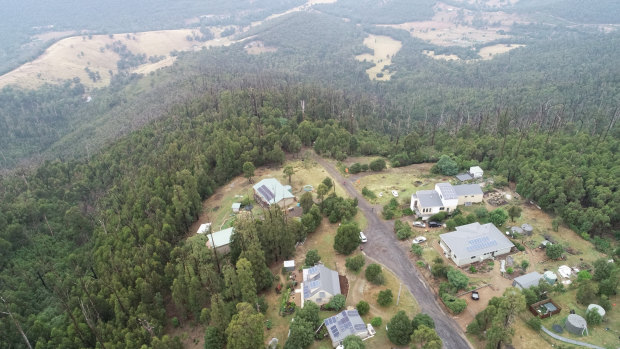
The edge of Pine Ridge Road, just outside Kinglake. This photo was taken on January 16, 2020.Credit: Jason South
“That one will not survive,” says Professor Kevin Tolhurst, nodding at a house on his left. “Neither will that one.”
We stroll to the edge of the road, where it starts to slope steeply away. There is a bare patch here. A "For Sale" sign has been stuck in the yard. We’re surrounded by trees.
From here you can see further down the hill. Stretching away beneath us is kilometre after kilometre of rolling green forest. In 2009, the fire roared through that forest, charged up the hill and destroyed this little strip of houses.
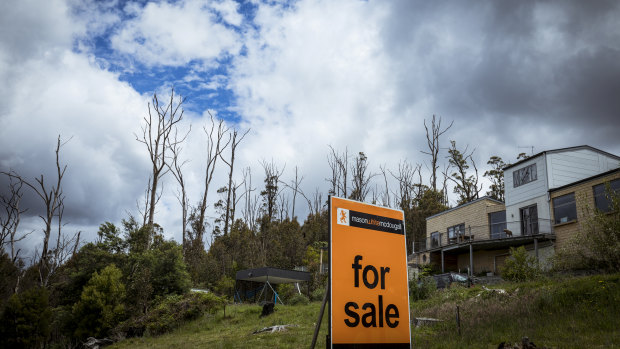
A 'For Sale' sign on Pine Ridge Road, Kinglake. This photo was shot in November 2019.Credit: Chris Hopkins
A decade later, the forest has grown back. Tolhurst believes it has grown back dramatically more flammable than before the bushfire.
Much of this thick forest grows in a heavily populated ring running 120 kilometres around Melbourne.
We are trapped in a spiral, Tolhurst argues.
The climate crisis is making big fires more likely. Each time a big fire burns the bush it becomes more flammable, leading in turn to more big fires.
To break that cycle, he believes we need to implement the recommendation he crafted as part of the 2009 Bushfire Royal Commission’s expert panel: burn at least 5 per cent of Victoria’s public forests every year.
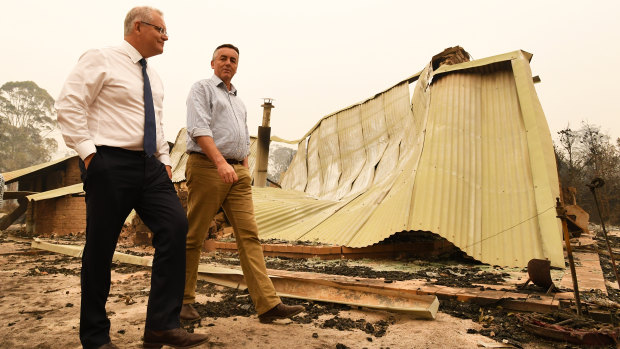
Prime Minister Scott Morrison and Gippsland MP Darren Chester tour fire destruction in Victoria.Credit: Getty Images
As the Prime Minister leads the charge on planned burning, calling for national hazard reduction standards, the scientific evidence is split on whether he - and Tolhurst - are right.
Many scientists argue a fire in extreme conditions - becoming more likely as the climate heats - won’t be slowed down by a planned burn.
“We’re in record drought. We’re seeing the effects of the climate crisis. You cannot say that’s just down to more fuel," says Professor Ross Bradstock, one of Australia's leading bushfire scientists.
“It is misleading to suggest that prescribed burning will provide the sole means of risk minimisation. Risk goes up and down. It does not go up forever."
Professor Bradstock led a comprehensive 2010 study that found planned burns do almost nothing to stop bushfires.
But the 2009 Royal Commission concluded what planned burning had been done did cut the spread of the fires on Black Saturday and helped firefighters contain them. And one 2013 study found that as Western Australia halved the amount of planned burning it does over the last 30 years, the size of bushfires in the region quadrupled.
Burning trees makes them more flammable
Tolhurst is one of Australia’s most respected bushfire experts. He was in the state control centre on Black Saturday, working with bushfire analysts; later he was one of the Royal Commission’s appointed planned burning experts. He remains a bushfire researcher at the University of Melbourne.
He and the man behind the wheel of the jeep, Victoria’s former chief fire officer Gary Morgan, are foresters, a profession which conjures images of men with thick beards living in the wilderness. That is not far from the truth. Tolhurst’s hobbies include finding and registering historic trees for the National Trust. His beard is voluminous.

Kevin Tolhurst in 2009. He was in the state control centre analysing the fires on Black Saturday.Credit: Rebecca Hallas
It seems like common sense: if you burn a forest, it will take decades to grow back ready to burn again. Hence areas burnt in Black Saturday shouldn’t burn again any time soon.
This, Tolhurst believes, is wrong. It takes as little as four years for landscape to grow back after an intense raging bushfire. When it does, it is more flammable, he says.
“Wherever there was one tree, now there are 10 trees, or 50 trees,” he says. “And the chances are it will burn again. So those 10 trees will become 100 trees.”
Why? First, an extremely hot fire kills big trees. This opens the way for a lot of new, small and much more flammable trees to grow in their place.
After a fire, thick shrubs and bushes grow back at ground level, Tolhurst says. And young trees make up a mid level. Up above, fire encourages eucalypts to spawn thick canopies.
We’re standing in a patch of eucalypt forest near Kinglake burnt in 2009. Tolhurst traces a line upward. This is not a forest, he says. It’s a ladder, with foliage at each level, allowing the fire to race up into the thick forest canopy, where it turns into a mega-blaze.
Planned burns are different, says Tolhurst. Done right, they burn cool and slow.
Further down the highway, Morgan turns left into Castella Road. A planned burn went through here in 2008. The forest floor is shrubby, and the eucalypts stand tall and erect. But there are no young trees, no mid level. The planned burn took it all off. We crane our necks to look up at sunlight filtering through the thick canopy.
No way fire is getting up there, says Morgan.
Maybe. Other scientists argue when the conditions are bad enough, fire will burn anything.
"There's so much heat and strong winds that the fire is able to travel across landscapes regardless of whether they've been burnt previously. It doesn't affect the [fire] behaviour,” University of Tasmania planned burning expert Professor David Bowman told the ABC.
Large parts of Australia’s landscape crave fire, Tolhurst and Morgan argue. Our trees and animals are adapted to it after thousands of years of bushfires lit by lightning strikes and Aboriginal burning practices. Dry eucalypt forest needs low-intensity fire every decade or so to stay healthy.
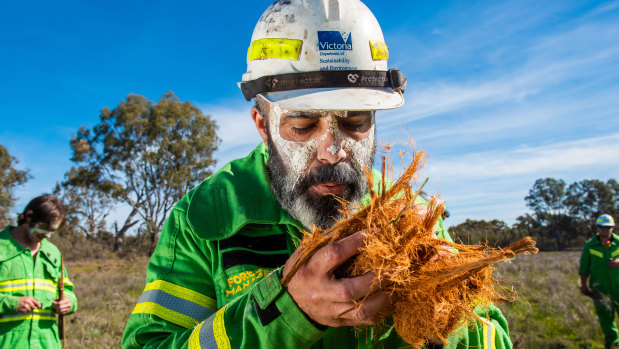
Mick Bourke at a Dja Dja Wurrung/Barapa cultural burn in Boort in September 2019.Credit: Brendan McCarthy
“We have stories, we have research documents, that state that when first settlers were coming into our areas, they saw smoke plumes across the country,” says Trent Nelson, chair of the Dja Dja Wurrung Clans Aboriginal Corporation. Dja Dja Wurrung territory centres around Kooyoora State Park in central Victoria.
“Traditional owners were burning country nearly every day of the year. Fire was in the landscape,” says Nelson.
Fire returns nutrients to the soil. They change the environment, making way for mosses and lichens – which recycle their own nutrients - to thrive. Cool blazes lead to rapid growth of small plants which feed insects, which in turn feed small birds. Scientists recently discovered bats love to roost under the curled, blackened bark. Possums, mallee fowl and parrots shelter in old bits of bush but get their most nutritious food from newly-burnt patches.
Forest Fire Management Victoria, working with traditional owners, last year reintroduced cultural burning to some parts of the state.
The fires the Dja Dja Wurrung light are exactly the type Tolhurst talks about: slow-burning, less intense. That gives animals and insects plenty of warning to flee, says Nelson.
Phil Cheney spent his career working as a fire behaviouralist for the CSIRO and was on the Royal Commission’s expert panel after the 2009 blazes.
He recently travelled through a part of Gippsland untouched by fire for too long. “You could see the tops were dying off,” he says. All the nutrients had been leached from the soils. “It’s an indication the health of the whole system is declining.”
Importantly, a healthy forest needs a patchwork mosaic of burnt areas. Possums, mallee fowl and parrots rely on recently burnt areas to feed, but live in old-growth areas that are full of good nesting sites.
Over lunch, Morgan pulls out his phone and shows off an image of a dot painting he’s had commissioned by Pauline Bonney, a Wongi artist from Western Australia.
It’s a stand of banksia trees being licked by flames, the fire a matrix of red and purple and black dots. Banksias need fire to open their seed pods and spread the seed. Without fire, they die. “Fire’s not about destruction,” says Morgan. “It’s about regeneration.”
A history of fires - and unmet targets
Planned burning tends to follow a pattern.
A huge fire rips through the state, destroying homes and taking lives. Afterwards, an investigation or Royal Commission sifts through the ashes and lays some of the blame for the fire on inadequate planned burning.
This happened in the 1939 and 2009 royal commissions, the 1983 Ash Wednesday bushfire review, the 2002-03 Victorian bushfire inquiry and a 2008 parliamentary inquiry.
A target is then set. The government, anxious to act, implements it.
And then, often within just a few years, the target is either dropped or ignored.
Take the 2002 Victorian bushfires. Afterwards, the secretary of the state’s environment department set a long-term aspiration of burning about 260,000 hectares a year.
By 2008, the same bureaucrat told Parliament the government was trying to move away from hectare-based targets.
In the lead-up to Black Saturday in 2009, the environment department was targeting about 130,000 hectares in planned burns every year. The department wanted to do more, but that was the limit of what they could do given their financial resources.
Fire crews at Kinglake and Strathewen reported seeing so much timber in the landscape they knew they would be powerless to stop a fire if it took off.
The 2009 Royal Commission convened a panel of experts. It reviewed thousands of published studies. It heard from fire experts around the world.
It recommended a minimum of 385,000 hectares of Victorian bushland be burnt every year.
The government accepted the recommendation. For a brief window, we almost implemented it, treating more than 250,000 hectares in 2012-13 with burning and other risk-reduction measures.
It wouldn’t last.
The problem with hectare-based targets is they can encourage indiscriminate burning. This, according to reports from both the the Bushfire Royal Commission Implementation Monitor and the Inspector-General for Emergency Management, is exactly what happened.
Huge swathes of scrub that was of no risk to anyone was burnt, the reports found.
“There were problems in achieving the [Royal Commission] target, and that a lot of areas in western Victoria were being treated that had very little value in terms of risk reduction,” says Professor Bradstock, himself a member of the Royal Commission’s expert panel.
Both recommended the hectare target be dropped and replaced with a different kind of target. Rather than burn a given amount of bush, they advocated burning to cut risk by 20 per cent compared to what the risk would be if no planned burning was done at all.
At about the same time, a planned burn in Lancefield got away, consuming several homes. The government, under pressure, dropped the 350,000-hectare goal, replacing it with a risk-based target.
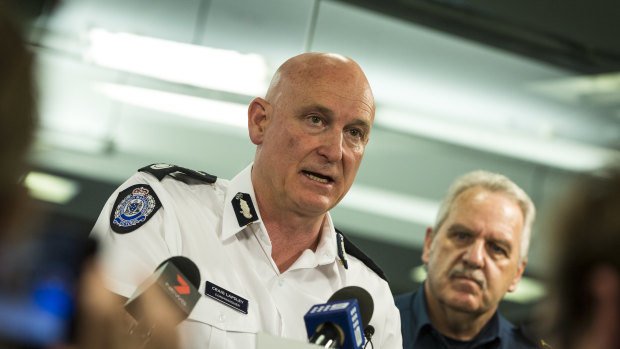
Former Emergency Commissioner Craig Lapsley, seen here at a news conference in 2018.Credit: Chris Hopkins
“It was the right decision,” says Craig Lapsley, who was head of Emergency Management Victoria at the time. “However the application has now shown there has not been enough burnt.”
Immediately after the target was dropped, the amount of land treated nosedived, down to just 74,728 hectares in 2017-18, before increasing to 130,044 hectares in 2018-19.
The Age does not suggest dropping the target is directly linked to a fall in the amount of land treated. Planned burns are notoriously difficult to do safely - the weather has to be hot enough for a blaze, but cool enough that the blaze can be kept under control. There are perhaps 10 days a year with the right weather conditions.
In 2013-14, for example, Victoria had a hectare-based target but managed to burn only 82,022 hectares.
“It is harder and harder to find enough days for the safe and effective conduct of planned burning,” a spokesman for the Department of Environment, Land, Water and Planning said in a statement.
“The suggestion we're not prepared to undertake planned burns is wrong and anyone claiming it is either misinformed or deliberately spreading misinformation.”
Still, three members of the expert panel appointed by the Royal Commission told The Age they strongly condemned the decision to drop the target.
“It’s politics,” says Professor Mark Adams, a bushfire scientist now based at Swinburne University. “It’s not science. It’s politics.
“The expert panel arrived unanimously at that figure of 5 to 10 per cent. Unfortunately, some of the members of the panel have seemingly changed their views since then.”
Phil Cheney was blunt.
“The long-term consequences of dropping the target is what is happening in NSW right now.
“You will burn.”
A burning political football
Since huge blazes ripped through East Gippsland, burning down hundreds of homes, planned burning has become - once again - a political football.
Prime Minister Scott Morrison is expected to pressure the states to ramp up prescribed burning, and has been discussing national standards for hazard reduction.
At a news conference earlier this month Victorian Premier Daniel Andrews was quick to defend his record.
"I think there's some good examples of where land that had been backburned quite hard — quite heavy fuel reduction burning only three or four years ago — burnt pretty hot last weekend,” he said.
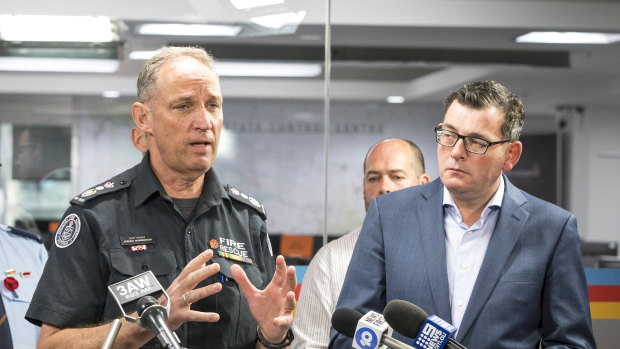
CFA chief officer Steve Warrington flanked by Daniel Andrews.Credit: The Age
The Country Fire Authority's chief officer Steve Warrington, standing along side him, labelled claims planned burning was “the solution to all our problems” as “really just quite an emotional load of rubbish”.
“The suggestion we're not prepared to undertake planned burns is wrong and anyone claiming it is either misinformed or deliberately spreading misinformation,” a spokesman for the Department of Environment, Land, Water and Planning said in a statement.
And record levels of hazard reduction in NSW do not appear to have stopped the mega-fires there.
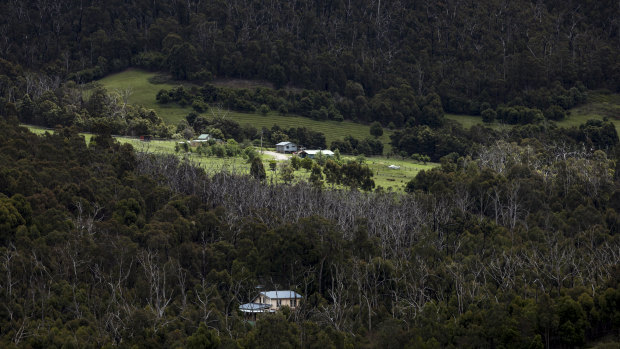
Housing in the Strathewen/Chads Creek Road area.Credit: Chris Hopkins
We arrive at a lookout atop Mount Sugarloaf. Below us, tucked in a valley, sits the sleepy town of Strathewen. Local authorities have worked hard to build big clearings around it to stop fire reaching the town.
If there is a big fire, they are next to useless, says Tolhurst.
We look the other way, towards a row of hills. Mount Disappointment towers in the distance. During Black Saturday, the fire raced up the mountain. It moved so fast that when it reached the top, rather than burning down into the valley below, it simply leapt to the next peak. And then to the one we’re standing on.
And then it catapulted flaming embers the size of fingers down into Strathewen.
Twenty-two people died in the town.
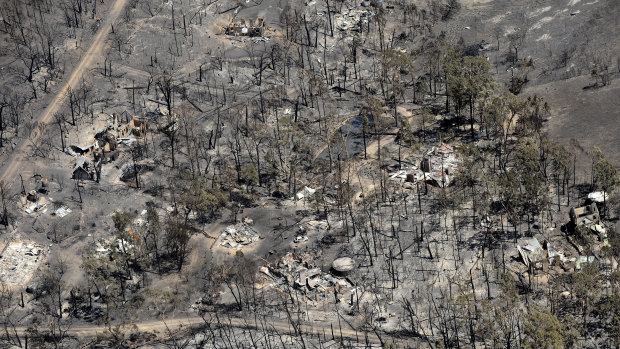
Strathewen two days after the 2009 bushfires fires ripped through.Credit: Craig Abraham
But look around, says Tolhurst. The danger is not down there in the town, where the clearing has been cut – it’s up here, where we’re standing. And this patch has grown back more flammable than it was before.
All the waterbombers in the world won’t stop a fire that can leap mountains in a single bound, he says.
Other experts disagree. Cleared buffer zones within 40 metres of houses were far more effective at reducing house losses than planned burning, says associate professor Philip Gibbons, a bushfire researcher at the Australian National University.
"This summer's fires have burnt though many areas that had hazard-reduction burning. They can help control fires in moderate weather conditions, but in severe conditions it might just help reduce the severity," he said.
"If there was a silver bullet on bushfires we'd have found it by now, after the 51 inquiries since 1939."
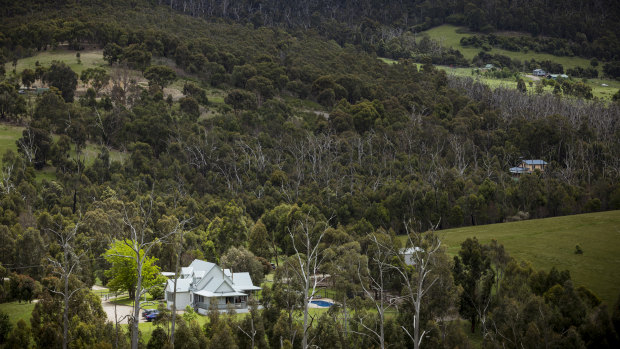
Another view of the Strathewen/Chads Creek Road area.Credit: Chris Hopkins
Later, heading back to Melbourne, Morgan pulls off to the side of a road as we head into Steels Creek. On our right, a house surrounded by a large clearing. On our left, thick forest.
Morgan nods at the house. He’d be feeling pretty safe, he says. Hundred metre-plus clearing. No way for the fire to get to him.
Tolhurst leans forward from the back seat. This forest burnt intensely a few years ago. See how it’s grown back with much more fuel than last time? If it burns hot, thousands of pieces of bark will curl off these tall eucalypts, ignite, and fly toward the house. They can travel for kilometres. They will get into the attic and under the veranda and ignite, and the house will burn down.
What happens if we don’t take action?
“We’re seeing that now. Disaster after disaster,” says Tolhurst.
with Mike Foley